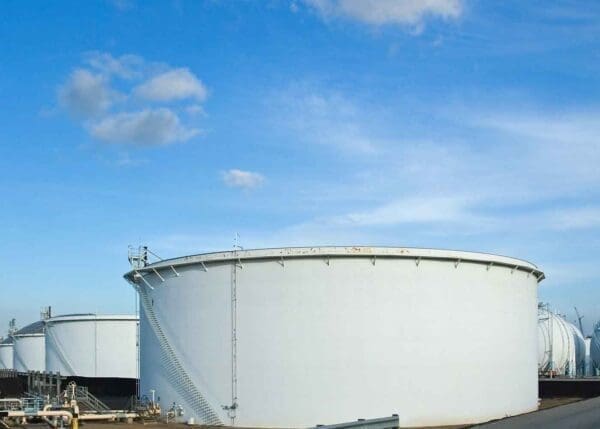01. Asbestos Use at Oil Refineries
How Was Asbestos Used at Oil Refineries?
Asbestos was used for many years in petroleum refineries. Petroleum is highly flammable and can cause explosions. As such, oil refineries required use of fireproof materials. Asbestos provided heat and chemical resistance at refineries.
Asbestos could be found throughout oil refineries, oil ships and oil platform facilities. Common asbestos-containing products found at refineries include construction products, refinery equipment and flame-resistant materials.
Asbestos insulation, gaskets, valves and other asbestos-containing materials were also produced specifically for use in petroleum facilities.
In addition to asbestos use in construction products and equipment, workers also faced exposure from protective clothing. Fireproof clothing, such as gloves, often contained asbestos to protect workers from burns and dangerous chemical reactions.
Although the mineral was useful to protect otherwise flammable materials, it is a dangerous carcinogen. The mineral is not banned entirely in the United States and old asbestos materials may still be in use. As a result, thermal insulation and other structural asbestos materials may still be found in old buildings.
Individuals risk exposure when working on or removing asbestos products. Oil refinery workers exposed to the airborne fibers are at risk of developing asbestos-related illnesses, including lung cancer and mesothelioma cancer.
02. Notable Companies
Notable Companies That Used Asbestos in the Oil Industry
Many petroleum companies used asbestos products. This includes well-known, modern-day oil companies, such as Chevron, Shell and ExxonMobil. However, they often did not manufacture these products.
Other asbestos companies produced products to sell to petroleum producers. This includes the A.W. Chesterton Company, Armstrong International, Owens Corning, Quigley Company and North American Refractories Company (NARCO).
A.W. Chesterton Company
A.W. Chesterton Company was founded in 1884 and continues to operate today. The company manufactured asbestos gaskets, seals and packing. Its asbestos products were used in many industries, including the petroleum industry.
Asbestos began appearing in A.W. Chesterton products in the 1920s. Many of the company’s products included asbestos for heat resistance and chemical durability. This asbestos use ceased in the mid-1980s.
The company has been named in many lawsuits as an asbestos component manufacturer.
ExxonMobil
ExxonMobil was founded in 1999 through a merger of two oil companies. Exxon’s predecessors were Exxon (formerly Standard Oil Company of New Jersey) and Mobil (formerly Standard Oil Company of New York). Today, it is one of the world’s largest oil and gas companies.
ExxonMobil’s predecessor companies can be traced back to 1870 with John D. Rockefeller’s Standard Oil Company. As a result of this long history, ExxonMobil has inherited many asbestos lawsuits.
Asbestos exposure at ExxonMobil, or any of its predecessors, could have happened on oil ships, in shipyards or at refineries. These companies used asbestos in ship construction, building construction, refinery equipment and safety clothing.
Texaco, Inc.
Texaco, Inc., also known as The Texas Company, was founded in 1902 in Beaumont, Texas. It is a subsidiary of the Chevron Corporation, one of the world’s largest companies.
Texaco, Inc. used asbestos products in its oil tankers and oil refineries. The company used asbestos to coat pipes, reinforce concrete, insulate refineries and provide a durable seal in gaskets.
As a result of this asbestos use, the company continues to face many asbestos lawsuits. It is often named as a defendant alongside product manufacturers such as A.W. Chesterton Company and Atlantic Richfield Corporation.
Other Oil Companies That Caused Exposure
Many petroleum producers used asbestos products. These products were often manufactured by other asbestos companies. As a result, there are many potential asbestos exposure sites related to the oil and gas industry.
Below are oil refineries in the United States that have utilized asbestos and led to exposure:
03. Who Is at Risk?
Who Is at Risk of Exposure at Oil Refineries?
Individuals exposed to asbestos on the job are among the highest population at risk for mesothelioma.
A 1991 study reported 90% of oil refinery workers came into contact with asbestos.
When asbestos products break down, asbestos dust may be released into the air. Anyone in the area may inhale these fibers and risk asbestos-related illnesses.
This could include anyone who worked hands-on with asbestos-containing materials, such as welders, insulators, mechanics and pipefitters. However, industrial workers were not the only ones at risk for occupational asbestos exposure.
In one study, researchers examined asbestos disease incidence among maintenance workers in refineries. This study revealed between 96 and 100% of their mesothelioma cases were attributable to workplace asbestos exposure. The researchers also found 42 – 49% of lung cancer cases among the oil refinery maintenance workers were attributable to asbestos exposure.
Prolonged periods of work at refineries are more likely to lead to an asbestos-related disease. Various studies demonstrate this increased risk of asbestos illness, including:
- A 2007 study found individuals who worked at a refinery for 10 or more years were twice as likely to develop an asbestos illness than employees who worked for one year.
- A 2017 study of more than 200 industries found refinery workers had one of the highest malignant mesothelioma mortality rates.
Individuals working around asbestos may also unknowingly expose their loved ones and families to the mineral. Fibers can remain on their clothing and personal belongings, even after they have left an asbestos worksite. As a result, loved ones may experience secondary asbestos exposure.
Exposure of any kind can cause asbestos diseases, such as asbestosis or asbestos lung cancer.
To mitigate the risk of occupational exposure, the Occupational Safety and Health Administration (OSHA) has set laws and regulations to protect workers. This includes issuing protective equipment to employees working in areas with an asbestos concentration.
These laws typically center around safely handling and disposing of the mineral.
04. Asbestos Lawsuits
Asbestos Lawsuits and Compensation
Many individuals were exposed to asbestos by the oil industry. They may be able to receive compensation for diseases tied to exposure from asbestos companies.
Some companies have set up asbestos trust funds to compensate victims. If a company does not have a fund, asbestos victims may be able to pursue a lawsuit or mesothelioma settlement.
An experienced mesothelioma lawyer will often provide a free consultation to help victims figure out which legal option is right for their situation.




